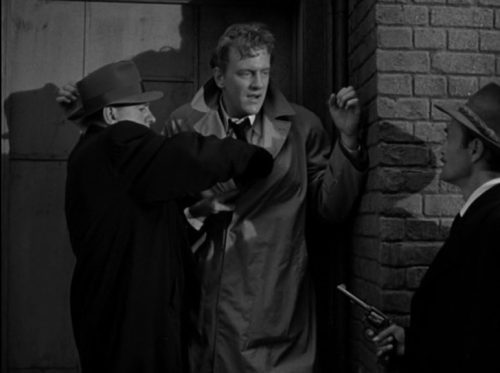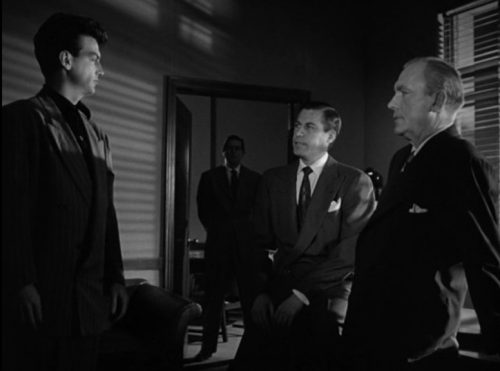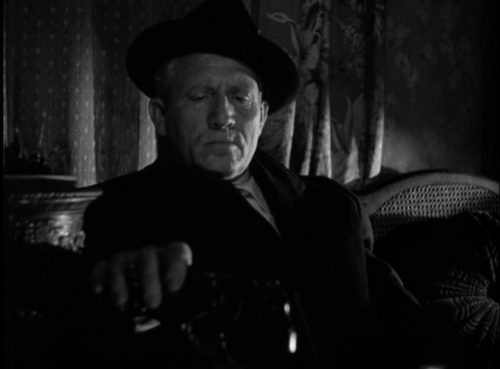“You can’t stop what’s coming.”
Near the end of the 2007 neo-noir No Country for Old Men the homespun truism quoted above is shared with the lead character, a man seeking to make some sort of sense out of a world that is not only passing him by but practically speeding off over the horizon. That feeling of inevitability, of random and relentless occurrences that cannot be avoided but only faced and dealt with if or when they appear, is something which has fueled film noir right from the beginning. The People Against O’Hara (1951) is one of those fatalistic studies of the inevitable, where the unraveling of a crime goes hand in hand with the unraveling of a man’s life.
New York streets by night, rain slicked and neon drenched, a grizzled seaman contemptuous of the noisy jukebox drifts out of a bar that could have been painted by Edward Hopper. Out on the street he pauses by the kerbside and is startled by the sound of gunfire from across the way, where a killer and his victim are silhouetted in the glare spilling from a doorway overlooking the sidewalk. The identity of the dead man is soon established, and the forensics team are quick to quick to obtain evidence of who had been driving the car used for the getaway. There is no doubt about the name of the wheelman, but establishing who did the shooting may not be such a cut and dried affair. The prime suspect is the owner of that vehicle, Johnny O’Hara (James Arness). The viewer knows he can’t have done the deed as he is shown out of town trying to break up for good with a distraught and emotional girl. And there, in the words of a well-known prince of Denmark, is the rub: that clinging, desperate girl is the wife of a notorious gangland boss (Eduardo Ciannelli), a man known to visit unspeakable and horrific vengeance on anyone stupid enough to cross him. Under the circumstances, it should not come as any surprise to see O’Hara make a run for it when as yet unidentified but armed men approach him on his way home. Nor is it hard to understand his steadfast refusal to offer an alibi for the time the murder took place, not when he is charged, not when a blatantly crooked witness falsely implicates him, and not even when he finds himself on trial for his life.
Not to put too fine a point on it, this is an extraordinarily delicate situation, one requiring deft legal skills if the accused is to have any chance of beating the rap and remaining in one piece. The O’Hara family’s hopes are pinned on one man, noted attorney James Curtayne (Spencer Tracy). However, this may be a distinctly shaky foundation on which to build anything, least of all the fate of a man facing a capital charge. Curtayne has retreated from criminal trial work, the pressures and strains of which had exacerbated his alcohol dependency. Still, it’s a rare Irishman who can cast off the cloak of sentimentality with ease, and the pitiful entreaty of old acquaintances fallen on hard times is a siren call that is hard to resist. The odds are poor though; the case, despite being shored up by a wall of deceit, is a tough one, the client is paralyzed by an unholy combination of fear and nobility, the D.A. (John Hodiak) is sharp and dedicated, and Curtayne knows he is slipping, that the ground is falling away beneath him while he is too weary and damaged to regain a firm footing. It’s that inevitability, a remorseless sliding sensation, one which although it cannot be halted may yet offer one last shot at a form of redemption.
The People Against O’Hara was the first of three films that John Sturges and Spencer Tracy would make together, being followed by the better known Bad Day at Black Rock and The Old Man and the Sea. It hails from that relatively early period in Sturges’ career when he was working in all kinds of genres. He would really be in his element within a few years as the widescreen process took off and he quickly became one of its top practitioners with a wonderful eye for composition and placement. The pictures he moved on to direct often afforded him the opportunity to incorporate landscapes and outdoor shooting in general into his visual toolkit, and The People Against O’Hara also features some excellent use of genuine Manhattan locations. Having John Alton as cinematographer practically guarantees a strong visual aesthetic. Equally adept in color or black and white (his work with Anthony Mann is justly celebrated but he created some terrific images for Vincente Minnelli too, for example) he effortlessly brings a classic noir look to Sturges’ movie. The opening and closing scenes in particular are bathed in impenetrable, stifling shadow, characters in the foreground having their attention drawn into and fixed upon what Alton has highlighted deep within the background, and the viewer is hooked and reeled in in exactly the same way.
When I think of Spencer Tracy in legal dramas I automatically picture him in a couple of late career movies for Stanley Kramer (Inherit the Wind & Judgment at Nuremberg) and I suspect I’m not alone in doing so. As such, the image of characters with strong moral convictions and a deep-seated personal nobility is conjured up. Therefore, it’s something of a shock to see him don a rather tarnished crown in The People Against O’Hara. Here Tracy is not so much the staunch and steadfast pillar of legal ethics as a compromised, if not quite crumbling, monument to former greatness. He’s playing a man running on the fumes of a reputation, someone we get to meet on the downside of his career, shaken by alcoholism and ill-health and all the insecurities and frailties that come along for the ride. It’s perfectly clear that his heart is in the right place, although his willingness to head back into the criminal courts may be motivated not only by old loyalties and a sense of altruism, but also by an undeniable hunger for the old battleground and the possibility of new, revitalizing victories. So the honor and nobility are there, but they have acquired a vaguely seedy quality, coated by a film of failure and uncertainty, and Tracy communicates all that so well in those courtroom scenes where his frustration at his own faltering efforts and foggy thinking leave him humiliated and desperate, witnessing his hopes disintegrating before his eyes yet fully aware of his own impotence in the face of catastorophe. It’s that encroaching despair that drives him back towards the bottle and poor judgment, and opens the door to the dangerous road he ultimately opts for in order to justify his client’s faith and redeem himself.
John Hodiak is quiet, competent and scrupulous to a fault as the D.A. whose professional life is, by contrast, following a very different trajectory. The easy option in a story such as this would be to have the D.A. detouring down devious or flat out dishonest legal byroads. However, the calm decency which Hodiak conveys so effectively emphasizes the crisis unfolding in the life of his rival. It is not only the clever writing though, the coolly underplayed performance makes what might have been just another clichéd role into something real and credible. Similarly, old pro Pat O’Brien portrays his veteran cop in a nuanced and sympathetic way, neither as saint nor thug but as a normal human being able to empathize with the flawed people around him. Diana Lynn’s turn as Tracy’s anxious and devoted daughter is attractively done too; her big scene confronting her father as he is on the point of crashing spectacularly off the wagon provided an opportunity to ramp up the drama and she hits the right emotional balance in those moments.
The trend in film noir in the 1950s saw a slow drift away from the dark personal dilemmas that had been commonly explored in the preceding decade towards the broader social malaise represented by organized crime. A movie such as The People Against O’Hara feels like something of a halfway house. The mob connection heavily impacts the lives of the characters but the main focus of the film remains on the trials of Curtayne, the literal one he’s fighting in the courtroom and the spiritual one being waged for his heart and soul. All told, it makes for an attractive blend. Mob related material has a tendency to lean into the showier side in general and one of the flashier performances comes courtesy of William Campbell’s cheap hood. He is all smirks and smarm, faux indignation jostling for position with sugarcoated insincerity, adding layers of slime and a sickening unctuousness. Considerably higher up the criminal food chain comes Eduardo Ciannelli. He brings real menace to his part, those saurian features hinting at medieval malice. Even little throwaway scenes like his sharp exchange with an apparent laborer careless enough to splash his expensive clothes, leading to him dismissively talking about this “paisano” and making cracks about cutting out tongues, before revealing that the pleading supplicant is in fact his own father carry a real chill. In support, Jay C Flippen’s broadly sketched Scandinavian sailor is a fun addition and there are small parts for Arthur Shields (who contributed many a telling and memorable moment in a number of films for John Ford among others), Richard Anderson and, in a practically “blink and you’ll miss him” role, a young Charles Bronson.
The People Against O’Hara was released on DVD in the US by Warner Brothers as part of the Archive Collection a decade ago, and there is a Spanish edition on the market too. It is not a film that gets talked about all that often, probably getting lost in among other more celebrated titles in the respective filmographies of Spencer Tracy and John Sturges. I like it quite a bit as it hits a lot of the themes and motifs that draw me to the movies, and the quality of the personnel involved makes it undeniably attractive.





This may have been the first John Sturges I ever saw. I remember being really impressed by Tracy but as a young viewer found the downbeat tone depressing and it’s quite small scale a bit disappointing. Not seen it since, which I must remedy. Sounds great the way you put it, as ever!
LikeLiked by 1 person
I like it quite a bit – hope I’m not overselling it as a result. The truth is though that I reckon there’s a lot of good stuff going on in the movie, and much to admire. The ending is downbeat of course but the destination it takes us to feels like a natural one. Consequently, I find it both appropriate and, in its own way, satisfying.
LikeLike
I believe this to be one of your best-ever reviews, Colin. Such good writing, chum.
I saw this film for only the first time (unbelievably) in the past few months, having got hold of an excellent DVD. It is a fine film-noir example and a good story put on film superbly by John Sturges. The depth and nuance shown here could only have been achieved by actors able to reflect such and Spencer Tracy, John Hodiak and Pat O’Brien were just right. A sobering and downbeat ending was inevitable but I found the film a most satisfying watch. Highly recommended.
LikeLiked by 2 people
Thanks, Jerry.
Yeah, there’s not much wrong with the movie, is there? It was one I only caught up with at a relatively late stage too but I think it was worth the wait.
LikeLike
Yet another film I’ve never seen. Must try and get hold of it after your fine summing up.
LikeLike
I hope it’s not to difficult to track down, lots of food stuff in this, and a terrific cast.
LikeLike
John Sturges: Director of Western Classics:
The Magnificent Seven
Gunfight at the OK Corral
Last Train from Gun Hill
The Law and Jake Wade
Hour of the Gun …
Not sure I classify ‘Bad Day at Black Rock’ as a Western, but some do.
Can any other Director (except Ford) claim to have such legacy?
LikeLiked by 1 person
I suppose it depends on budgets, JCAlberta. I fully agree about Sturges’ place as a director of large budget westerns. And all you mentioned are top-notch, aren’t they?
But I like to give recognition to the George Sherman-Lesley Selander-Joseph Lewis end of western film-making too. Those three (and there are others) made many westerns though the budget was smaller of course.
As to Sturges- “Escape From Fort Bravo” is also fine.
LikeLiked by 1 person
Thank you Sir for your informed response.
I pretend no expertise. Merely a fan of these wonderful Movies.
LikeLike
Me too, JC. You and me, big fans both.
LikeLike
Howard Hawks directed Red River, and that alone would be enough to place him with Ford.
LikeLike
And Rio Bravo too.
LikeLike
Truly an Iconic Masterpiece. IMO.
LikeLike
Delmer Daves…Director of classic Westerns
BROKEN ARROW
DRUM BEAT
THE LAST WAGON
JUBAL
3.10 TO YUMA
COWBOY
THE HANGING TREE
Even THE BADLANDERS ain’t too shabby either.
LikeLiked by 1 person
I’m hugely appreciative of Sturges’ work as a western director, and I feel the same and perhaps even more so with regard to the contributions of Daves. Jerry’s point is well taken too, I think.
All of this reminds me of that post I did on western directors long ago.
LikeLike
Why didn’t I think of Delmer Daves?? Thanks, John. Some great westerns in that list too.
LikeLike
I agree with Jerry about the quality of this review, Colin – it’s an outstanding piece of writing and thinking. The quality of the people both behind and in front of the camera strongly appeals to me and I’ll try to track down a copy of the movie. If Sturges and Tracy had only ever done BAD DAY AT BLACK ROCK, they’d be in my pantheon of cinematic heroes.
LikeLike
If you admire Sturges and/or Tracy, or any of the other major players for that matter, you will appreciate the movie. John Alton’s cinematography of course represents another big draw.
LikeLiked by 1 person
Yes, I intended to mention the great John Alton whose work is top-notch in so many movies, perhaps especially suited to monochrome.
LikeLike
The bulk of his work was obviously done in B&W and he’s earned plenty of praise for that over the years, but his color films should not be dismissed.
BTW, I’m not suggesting here that you were being dismissive of it.
LikeLike
And I wouldn’t take it that way, Colin, of course.
LikeLiked by 1 person
Testing………
LikeLiked by 1 person
Sorry about the above Colin-Iv’e been having WordPress probs today and the reply grid has altered too but hopefully the following will get through OK
When I posted my Daves comment the other day I really did not have time to give your review the attention it deserved but I’ve read it now and it’s a corker, especially the first 2 paragraphs. Have not seen THE PEOPLE AGAINST O HARA and your review makes it sound a lot more Noirish than I was anticipating furthermore Maltin makes it sound a somewhat middling film something he does to lots of good movies.
Oddly enough I have THE CAPTURE on order another Sturges film that I have never seen-a Neo Western I guess? There’s another couple of early Sturges Noirs I’d like to catch up with MYSTERY STREET and JEOPARDY the latter odd because it clocks in at B picture length (69 mins) Both films are on Warner Archive double DVD double bills; pity they were not paired together. Another Sturges early Western or if you will Neo Western is the underrated THE WALKING HILLS. I do consider BAD DAY AT BLACK ROCK Sturges best Western or again,if you will Neo Western. Originally I understand BAD DAY AT BLACK ROCK was a Don Siegel project with Joel McCrea headlining. As that would have paired my favourite actor with my favourite director; therefore some bias on my part would be understandable.
LikeLiked by 1 person
Thanks, John, I hope you get to see the movie soon. I also recommend Jeopardy from Sturges, which I wrote up some years ago here. It was originally released on DVD in a Stanwyck set and Mystery Street came out in one of those WB noir sets paired on the same disc with Act of Violence.
LikeLiked by 1 person
Both “MYSTERY STREET” and “JEOPARDY” are films not to be missed, John. The latter film feels very natural and true-to-life in the first third of the film, after which nail-biting suspense takes over.
Just more very fine examples of Sturges’ work.
LikeLiked by 1 person
Pingback: The Sign of the Ram | Riding the High Country
Pingback: Domino Kid | Riding the High Country